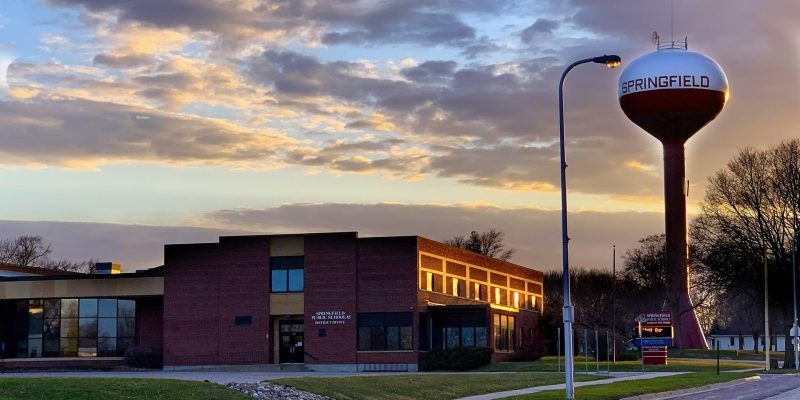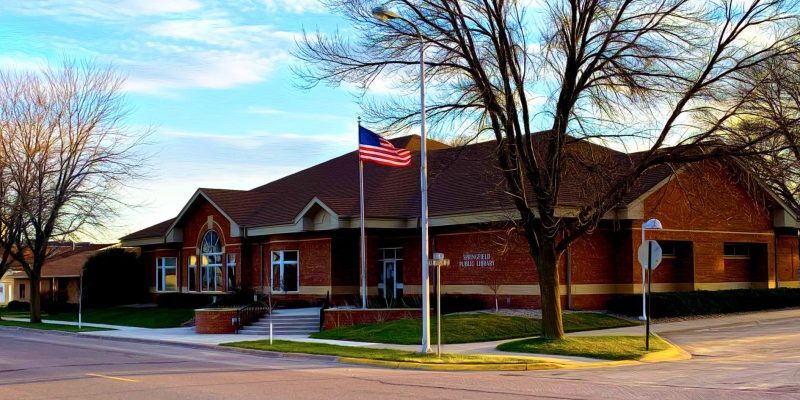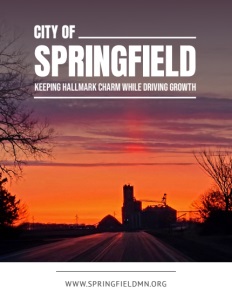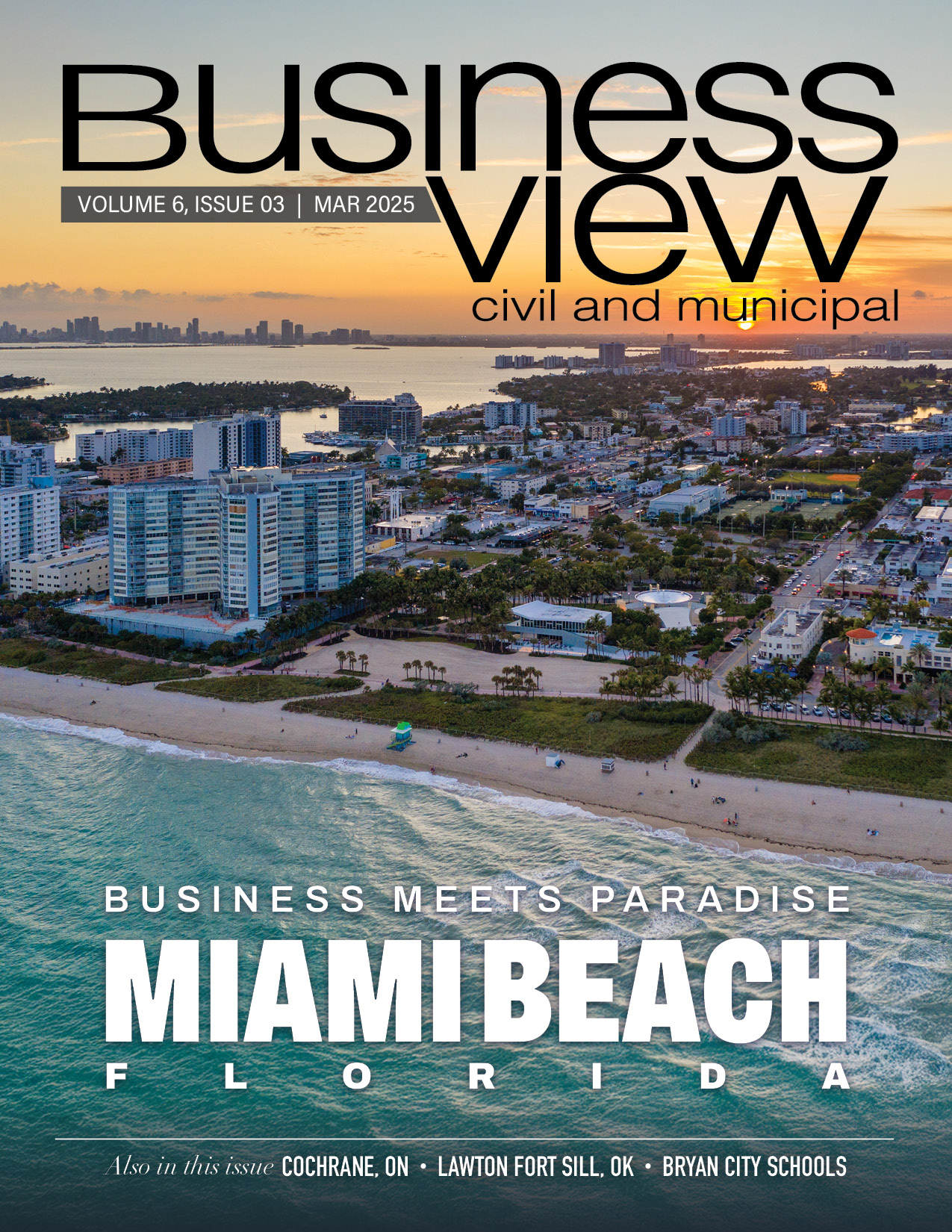Keeping Hallmark Charm While Driving Growth
A Midwestern town combines volunteer spirit with strategic planning to build a vibrant future while preserving its storybook appeal
If you’ve ever wished to step into a Hallmark movie, Springfield, Minnesota offers that storybook small-town experience in real life. “You’re going to see kids in the summertime riding their bikes with a friend,” says Heidi Wersal, Community Development Director. “It’s a safe community. Everybody knows each other’s names.”
The spirit of community cooperation runs deep in Springfield, where residents consistently unite to support local initiatives. “If something needs to get done, the community will always step up to help those in need,” Wersal explains. “Whenever we have a project whether it’s for the church, the pool, or the ball fields, everyone comes together to support it and works toward making it happen. It’s a great place to live, work, and explore.” This volunteer-driven approach has become a defining characteristic of Springfield’s identity, with countless hours dedicated to community improvement projects.
Ben Luense, Chairman of the Convention & Visitors Bureau, highlights the town’s aesthetic appeal and community pride: “When you drive through the residential area, you see nice homes, nice lawns, and flowers in the summertime. The downtown area is kept up and well maintained.” The care residents take in maintaining their properties reflects a deeper investment in the community’s future. “The fact that we have people willing to step forward whenever their help is needed makes it more enjoyable for people here,” adds Luense.
The Springfield Success Story: Emergency Services
The transformation of Springfield’s ambulance service highlights the city’s problem-solving abilities and strong community spirit. “Back in 2023, the city council was made aware that the ambulance service was being operated by just six members,” Luense recalls. “The options were to either abandon the service, seek help from nearby ambulance services, or recruit new members.” What followed was an extraordinary effort to mobilize the community and turn the situation around. Through coordinated action between the ambulance committee and city leadership, Springfield achieved a remarkable turnaround. “We went from six crew members to 24 in about six months,” Luense explains. “The city council stepped up by allowing employees to take ambulance calls during their workday. We found many employers willing to let their employees do the same.” The initiative drew diverse participants, from insurance agents and dispatchers to high school students.

The community’s financial support proved equally impressive. Equipment needs were met through local generosity, as Luense describes: “We needed radios and pagers to serve these people. A local foundation stepped forward and provided the funds to buy new radios.”
Clear communication played a crucial role in the project’s success. “We really try to be transparent with our community,” Wersal shares. “At first we were a little apprehensive about people getting worried we’re not going to have an ambulance, but we did a strong social media campaign, a couple of articles in our local newspaper, and we contacted our bigger employers in town. We went to the school, talked about it there, drew some interest from kids, and then everybody understood that this is something that’s needed.” This accomplishment earned Springfield the City of Excellence award from the League of Minnesota Cities in 2024.
Downtown Revival
Springfield’s downtown district is experiencing significant transformation as well, driven by strategic economic decisions. A pivotal move came with the sale of the city-owned Parkview apartments, as Wersal points out: “We decided to sell them because it really freed up a lot of money for our economic development authority to try to do more for the city.”
The immediate priority is addressing the infrastructure needs of existing businesses. “Our first item of business is to help some of our store owners repair their roofs or structural issues,” Wersal explains. These large, historic brick buildings are a significant part of our downtown. Our goal is to support the businesses within them and provide financial assistance to ensure their longevity. This practical approach will help preserve the historic charm of downtown while ensuring the buildings remain sustainable for years to come.
In addition to essential maintenance, the city has exciting plans for mixed-use development. “We’re exploring the possibility of converting some of the upper floors of these buildings into housing, as there’s a significant demand for it here,” says Wersal. John Ryan, Board Member of the Economic Development Authority, highlights the increasing interest in this concept: “Downtown apartment living is gaining popularity, and we’re interested in working on that aspect of it.” The goal is to preserve the authentic charm that makes Springfield unique while adapting to modern needs and opportunities.
Infrastructure and Development
Springfield’s evolving infrastructure and development landscape further spotlights the city’s strategic growth approach. The housing market in Springfield indicates high demand and limited inventory. Housing opportunities vanish quickly, as Ryan notes: “If a house comes on the market, it usually is sold within a week or so.” We do have a residential development that’s shovel ready, with utilities already in place,” Ryan explains. “We received a grant to address drainage problems so this spring’s storm water mitigation work will open up the area for further housing development.” The city is taking a progressive approach by establishing a housing trust fund to further support housing projects through grants, loans, and matching funds.
Springfield’s digital infrastructure has kept up with modern demands. “We have high-speed fiber internet throughout the entire city,” Ryan reports. “Nuvera Telecom completed the installation last summer.” This extensive fiber coverage positions Springfield for strong residential and business growth.
The city maintains an open stance toward commercial redevelopment, particularly regarding its former brick plant site. “We have a brick plant here which closed.,” Ryan shares, “We’re always looking at ways to redevelop that.” The former plant site includes several acres of land and borders the railroad tracks and the Cottonwood River.

Community Assets and Attractions
It is clear Springfield takes great pride in its community. That extends to assets like its municipal library, a vital part of community life that thrives thanks to local generosity. “Our library was originally built with donations, and it remains an essential resource in our town,” says Wersal. “Many community members continue to contribute to its upkeep, ensuring it stays in excellent condition.”
The Community Center, managed by Wersal, stands as another testament to local philanthropy, hosting a wide range of events that bring life to the city.
The city’s recreational offerings center around an expanding 40-acre Riverside Park campground, pool and sporting complex. “Everything is located just across the river from downtown,” Wersal explains. “We have 41 campsites which are full all summer, and we are going to add nine additional campsites this year.” The park’s crown jewel is its baseball facility, which she describes as “a beautiful baseball park, like a mini twin stadium, with the plaza where fans can buy a burger and a brew – the whole experience right here in Springfield!”
Recent developments have enhanced the city’s recreational infrastructure. “We have just finished a storm shelter softball complex this last summer partly through FEMA funds, but also funded through the city along with numerous donations,” says Ryan.

Tourism efforts highlight Springfield’s small-town charm and regional attractions. Special events attract crowds throughout the year, from the summer celebration, Riverside Days, which features a popular rodeo, to the Springfield Nativity pageant in December. “We bring in camels, donkeys, and goats, and narrate the Christmas story,” Luense adds. The small town hopes to reach a wider audience. “We’re currently working on creating videos to promote the city’s amenities and parks,” Luense reports.
Building for the Future
Business continuity occupies a central place in Springfield’s development strategy. “We received a grant to start a program helping entrepreneurs,” Ryan shares, “A lot of our business proprietors are getting to retirement age, so we’ve been working on succession plans to ensure that these businesses keep going.”
The Small Business Development Center (SBDC) has proven instrumental in nurturing Springfield’s entrepreneurial spirit. “We had a 23-year-old gentleman that wanted to buy an auto mechanic dealership,” Wersal explains. “To connect him to the SBDC was instrumental in securing funding to buy the business.”
The childcare sector is another key area of focus for community development. “We were awarded a grant to help find innovative ways to secure more childcare providers and help support our existing providers as well,” Wersal explains. “As a result, we’ve brought in two new providers in the last six months.” Additionally, the newly formed daycare association, Springfield CARES, is bringing together parents and community leaders to support childcare providers and expand available resources.
Springfield’s ambitious development agenda, backed by community resources and collaborative partnerships, positions the city for sustainable growth. While housing remains a primary focus, with development projects in the pipeline, the city’s holistic approach encompasses business succession, childcare expansion, and tourism promotion. These various initiatives have created a springboard for sustainable growth, enabling Springfield to address its challenges while preserving the small-town charm that makes it special.
At a Glance
Who: City of Springfield
What: A thriving small town known for its strong community involvement combining traditional values with progressive development initiatives
Where: Springfield, Minnesota
Website: www.springfieldmn.org
PREFERRED VENDORS/PARTNERS
Mead & Hunt delivers engineering, architecture, planning, and construction services nationwide. Ranked #81 on Engineering-News Record’s Top 500 Design Firms List, and #8 in Airports, the company has grown significantly since its founding 125 years ago. Markets include aviation, transportation, water, federal, education, food/beverage, renewable energy, and technology services.
Mead and Hunt: www.meadhunt.com



